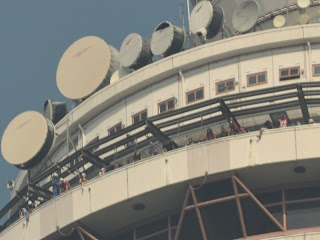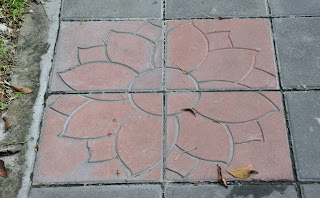
It's been a while since I've had nasi kandar, so I decided to have some for lunch. I gathered 2 of my colleagues and took the monorail to the Medan Tuanku station. From there we walked to Jalan Tuanku Abdul Rahman.
Even at a quarter past twelve, the queue was long.
We joined the queue and inched patiently along. Photo above is of Aidi and Norman at the front of the queue.
That's what we had. The green chilli is for that added 'kick' to the nasi kandar.

Of course, don't forget the pappadam.

This used to be a typical 'kopitiam' (Chinese coffee shop) when I knew it in the early 1960's. There were some stalls selling various food items like noodles and such, with the owner just taking care of the drinks. Then this 'Mamak' set up a small table to sell his nasi kandar in the kopitiam.
One thing led to another and before long, this became 'Restoran Kudu Bin Abdul'.
In case you're wondering what nasi kandar is, Wikipedia has this entry:
Nasi Kandar is a popular northern Malaysian dish, which originates from Penang. It is a meal of steamed rice which can be plain or mildly flavored, and served with a variety of curries and side dishes.
The word Nasi Kandar, came about from a time when nasi [rice] hawkers or vendors would kandar [balance] a pole on the shoulder with two huge containers of rice meals. The name has remained and today the word Nasi Kandar is seen on most Tamil Muslim or "Malaysian Mamak" restaurants and Indian-Muslim stall meals.
The rice for a nasi kandar dish is often placed in a wooden container about three feet high, giving it a distinctive aroma. The rice is accompanied by side dishes such as fried chicken, curried spleen, cubed beef, fish roe, fried prawns or fried squid. The vegetable dish would usually be brinjal (aubergine), okra (lady fingers or "bendi") or bitter gourd. A mixture of curry sauces is poured on the rice. This is called 'banjir' (flooding) and imparts a diverse taste to the rice.
Traditionally, nasi kandar is always served with its side dishes on a single plate. Nowadays, small melamine bowls are used for the side dishes. Nevertheless, the curry sauce mix is always poured directly onto the rice.
The most famous nasi kandar stalls in Penang are Kassim Restaurant and Line Clear. In Selangor, one chain of nasi kandar restaurants is Restoran Syed. In recent years, several chain restaurants have appeared such as Nasi Kandar Nasmir, Pelita Nasi Kandar and Kayu Nasi Kandar. Purists have disputed its tastiness compared to the original Penang versions. In Perlis, the rice is coloured yellow with herbs and the dish is referred to as "nasi ganja", though in fact no "ganja" (cannabis) is actually used in its preparation.
































































